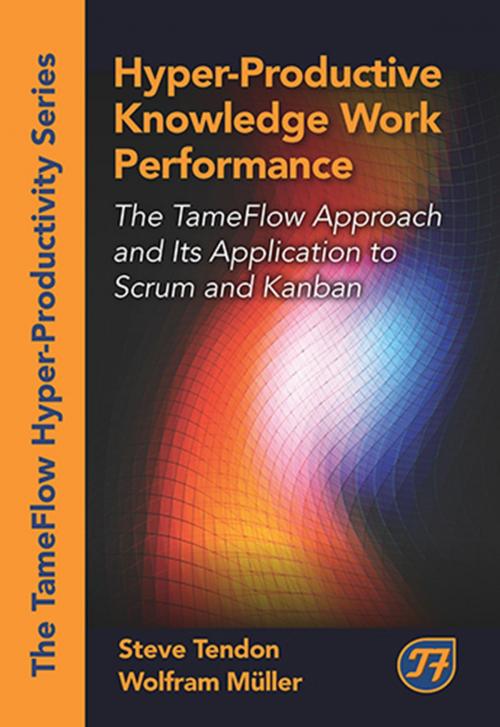Hyper-Productive Knowledge Work Performance
The TameFlow Approach and Its Application to Scrum and Kanban
Business & Finance, Human Resources & Personnel Management, Organizational Behavior, Management & Leadership, Management, Economics| Author: | Steve Tendon, Wolfram Muller | ISBN: | 9781604277579 |
| Publisher: | J. Ross Publishing | Publication: | December 14, 2014 |
| Imprint: | Language: | English |
| Author: | Steve Tendon, Wolfram Muller |
| ISBN: | 9781604277579 |
| Publisher: | J. Ross Publishing |
| Publication: | December 14, 2014 |
| Imprint: | |
| Language: | English |
By some estimates, knowledge workers outnumber all other workers in North America alone by a four to one margin. Knowledge work and knowledge workers vary with each profession, depending on the industry from software developers to engineers, architects to pharmaceutical researchers, and so forth. They are usually responsible for exploring and creating ideas, new products, new designs or perhaps new models for doing business to help their organization achieve or maintain a competitive advantage. As much of this type of work is intangible, productivity is a mystery to most business executives, managers and team leaders.This unique reference shows how to lead knowledge workers, manage knowledge work and build a hyper-productive knowledge work organization, by taming and managing the four flows of organizational performance (psychology, information, work and finance) to produce spectacular operational and financial throughput results.Inspired by his experience and knowledge gained at Borland International, where a hyper-productive level of performance was achieved resulting in the most productive software project ever documented, author Steve Tendon devised TameFlow. TameFlow is an approach that can be superimposed on any preexisting process, method, and practice to enable performance improvement by several orders of magnitude and a state of hyper-productivity. It is adaptable to nearly every industry, and can be applied to any knowledge work domain or organization that generates business value through knowledge.TameFlow blends and merges different ideas from a variety of schools of thought. It is founded in pattern theory and organizational performance patterns which are used to analyze and decompose processes, methodologies, and management practices into constituent parts to observe productivity patterns, and then they are recombined in new configurations to enable hyper-productive levels of performance.In this volume of The TameFlow Hyper-Productivity Series, the TameFlow approach is explained within the context of knowledge work performed in a software development organization. Mr. Tendon teams up with author, Wolfram Müller, a thought-leader and expert in Critical Chain and Advanced Agile Project Management to illustrate its application to Scrum, the most widely used Agile software project management framework, and to Kanban, a method used for knowledge work with an emphasis on just-in-time delivery and change management.The authors demonstrate how constraints management (TOC) can improve Scrum and Kanban in powerful ways, bringing more predictability of behavior of the system as a whole, as well as to the individuals involved. Their combination becomes a breeding ground for the development of Unity of Purpose and Community of Trust. Both Scrum and Kanban can be extended with features of the TOC, and help create a hyper-productive organization.
By some estimates, knowledge workers outnumber all other workers in North America alone by a four to one margin. Knowledge work and knowledge workers vary with each profession, depending on the industry from software developers to engineers, architects to pharmaceutical researchers, and so forth. They are usually responsible for exploring and creating ideas, new products, new designs or perhaps new models for doing business to help their organization achieve or maintain a competitive advantage. As much of this type of work is intangible, productivity is a mystery to most business executives, managers and team leaders.This unique reference shows how to lead knowledge workers, manage knowledge work and build a hyper-productive knowledge work organization, by taming and managing the four flows of organizational performance (psychology, information, work and finance) to produce spectacular operational and financial throughput results.Inspired by his experience and knowledge gained at Borland International, where a hyper-productive level of performance was achieved resulting in the most productive software project ever documented, author Steve Tendon devised TameFlow. TameFlow is an approach that can be superimposed on any preexisting process, method, and practice to enable performance improvement by several orders of magnitude and a state of hyper-productivity. It is adaptable to nearly every industry, and can be applied to any knowledge work domain or organization that generates business value through knowledge.TameFlow blends and merges different ideas from a variety of schools of thought. It is founded in pattern theory and organizational performance patterns which are used to analyze and decompose processes, methodologies, and management practices into constituent parts to observe productivity patterns, and then they are recombined in new configurations to enable hyper-productive levels of performance.In this volume of The TameFlow Hyper-Productivity Series, the TameFlow approach is explained within the context of knowledge work performed in a software development organization. Mr. Tendon teams up with author, Wolfram Müller, a thought-leader and expert in Critical Chain and Advanced Agile Project Management to illustrate its application to Scrum, the most widely used Agile software project management framework, and to Kanban, a method used for knowledge work with an emphasis on just-in-time delivery and change management.The authors demonstrate how constraints management (TOC) can improve Scrum and Kanban in powerful ways, bringing more predictability of behavior of the system as a whole, as well as to the individuals involved. Their combination becomes a breeding ground for the development of Unity of Purpose and Community of Trust. Both Scrum and Kanban can be extended with features of the TOC, and help create a hyper-productive organization.















